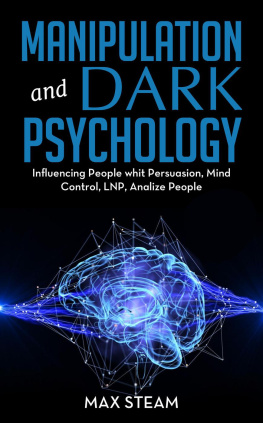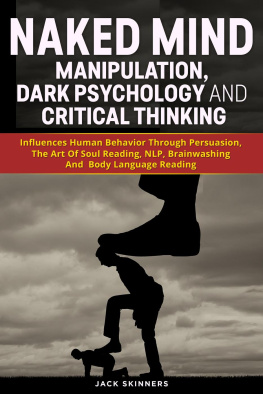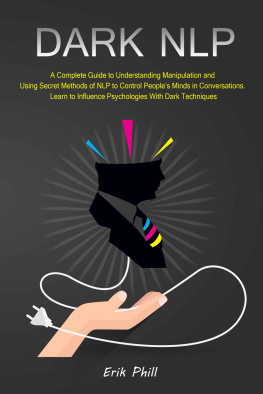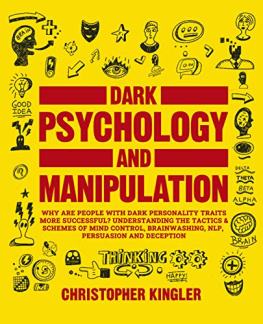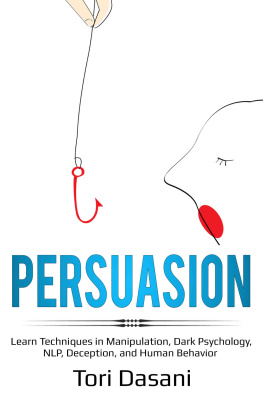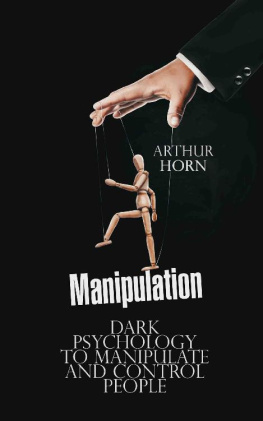Chapter 1: Dark Psychology
Whydoes psychological understanding of any risk cause physicalreactions? The answer is in human anatomy, more precisely, in thereasons of pain appearing. Is mental pain similar to physicalstrongpain? How does real pain occur? With physical strong pain, everylittle thing is uite clear. We do not take into account simplemotor reflexes that are performed under control of spine.
Duringphysical receptor sensation, the nervous impulse is transmitted vianerves to corresponding brain part, then the brain transfers aresponse impulse to an organ.
Howdoes mental pain happen? Our body has such function asself-regulation of all physiological procedures, in other words,brain responses on the change in the chemical processes in thebody.
Mostlikely, under the impact of feelings in the body happens some sortofchange, for example, in blood composition, then it is transferredtothe brain, and again the response impulse from the brain is sent toone of the organs and thus strong pain happens. This is called thepsychological cause of the real pain.
Forexample, when you fear darkness you could experience heartache orpain in the throat. You feel like someone stops your breathing.Hereyou fear not darkness itself but something that can be there in thedarkness. It is based upon gotten information about it throughoutyour life. A kid never ever fears the darkness till he or she isbeing told what can be in it. Let us call it consciousworry.
Suchphobias as worry of a concrete circumstances or thing, thatterrifiesyou with something and develops a feeling of worry and horror, arealso described as mindful worry because you feel this worry becauseof your bad experience or negative information gotten from somebodyelse. What is the nature of this worry? How does this worry happen?What do I feel? Uncertainty, embarrassment, dejection, lack ofexercise, anxiety, blame, injury, consternation, tension, andpanic.
Thereare psychological and physical experiences in your body. And thatmeans that worry is interconnected with other negative feelings.Onething causes another, and comes from the other, but means one andtheexact same thing.
Whatabout unconscious fear or, to put it simply, a simple fear notbasedupon this experience? What can it be? This can be the fear of theunpredictability, or the fear of the unidentified. For instance,children fear sounds, unknown things. Typically, from the verystartof human history, people were always frightened of inexplicableactsof nature. Or their worry was based on a phenomenon seen rightbefore.
Forexample, worry of the unidentified future, fear of possible thoughtnegative events. How do we learn that these are bad events? Wecompare possible events with skilled negative ones.
Itends up that we fear unknown things as we fear bad unidentifiedthings. We do not fear great unidentified things because they makeushappy. And when we feel worry, all great events we do forget. Inother words, when we think about an unidentified event in our mindathreatening image appears, as a result, happens a feeling of fearbased upon negative early knowledgeable worry. It means that worryofan unidentified thing is a mindful fear.
Chapter 2: The Importance of Black
Blackis not a color as such. Color is light and black is void of light.Actually, it takes in light, reflecting absolutely nothing back. Itis, therefore, warmer than white, which shows all colors,maintainingnone. Although both black and white aren't colors, asrepresentativesof lightness and darkness, they are responsible for all thebeautifulhues we see around us.
Emotionally,black is associated with total darkness and with the unknown. It isthe opposite of white. Whereas black is usually connected withwickedness, white represents light, pureness, and goodness. Infact,both have their positive and negative sides. White representssunshine. This light not only gives us heat and brightens up thespirit but, when the rays of light are too extreme, can lead toblindness. On the other hand, darkness makes every little thinginvisible and consequently triggers fear. Yet it is the darkness ofmeditation that allows us to become quiet and concentrated, so astofind the inner truth, the inner light.
Blackand white are actually inseparable. As agents for light anddarkness,they form an absolute polarity. As soon as the light isextinguished,darkness happens and when light appears, darknessdisappears.
Likeevery shade, black has two extremely conflicting ualities. Itsnegative side represents pity, depression, heaviness and, at itssevere, evilness. Favorably, it means stability, concentration,depth, weight, power, and exclusivity. It is strange with limitlessdepth. Those who do not fear this will experience black as highlyspiritual; those who fear these ualities will see it as hazardousand evil.
Blackis used to expressing the fearful and the magical. It stands forexclusivities or class, like for the black limousine or the blackevening gown. It is certainly the favorite color for signifyingluxury and status. Its enormous depth gives it a powerfulattraction.
GETTINGRID OF YOUR WORRY OF DARKNESS USING HYPNOSIS
Beingafraid of the dark is not something that one should be embarrassedby. Self-hypnosis is a practice that can supply a person with anescape of this disabling worry. It does so in 3 ways:
1.Understanding the fear
Totreat this fear of darkness, one need to initially understand it.Worry of the dark is an intrinsic human characteristic that goeswayback to ancient times. In essence, being conscious enough not towander off in the dark has kept lots of the people in ancient timessafe. The reason for this is that man does not have the capabilitytosee clearly in the dark, leaving people susceptible to mostpredators, specifically in the wild.
Theissue with this fear is that the majority of the modern securityprocedures have rendered most troubles found in the dark void. Ifyour place is secure enough, then being afraid of the dark isunfounded and uite troublesome. In most cases today, the worry ofthe dark revolves around fictional specters and creatures that areenvisioned to be looming around dark corners.
2.Going back
Thefear of darkness is psychological in nature and therefore must betreated like a phobia in hypnosis sessions. Many phobias related todarkness are caused by deep mental trauma in the past, particularlythroughout childhood. A hypnotherapy session will have you rememberthose memories which triggered your fear
Thereason for reviewing the memories is to let you experience themonceagain, but, this time, with an older frame of mind. Recalling theexperience with a brand-new perspectives will work in letting youunderstand that the dark is not so frightening after all. In manymemories, the support of a professional is needed specifically ifyouwere deeply shocked by such an occasion.
3.Removing the fear.
Peopletend to be more afraid of the dark the more they avoid it. Inseverecases, immersing yourself in the very thing that you feared canhelpyou redefine your principle of it. When it comes to darkness, thismeans denying yourself of light to depend less on it for securityandsecurity in the dark, specifically when you're sleeping.
Insome cases, you might have even needed to re-associate darknesswithless than threatening principles like safety, peace, comfort, andsleep. The hypnosis session will enable your brain to gradually getaccustomed to abrupt lacks of light and help you react effectivelyshould such emergencies emerge.


